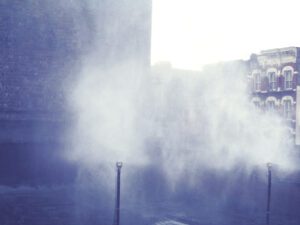Joana Hadjithomas and Khalil Joreige map out a genealogy of e-mail scams in the latest exhibition taking place at Manchester’s HOME. The Beirut-based visual artists have collected and studied more than 4,000 items of junk mail since 1999, and have reconfigured them through film, sculptures and photography in an exciting installation entitled I must first apologise…
You know this won’t be a run of the mill offering as soon as you enter the first room. There, you stumble through darkness and listen to the incessant chatter emitting from 17 TV screens and 100 loudspeakers. The Rumour of the World (2014), a set of films of non-professional actors of various ages and origins, bombards you with a cacophony of recited scams and stories in the darkened room, weaving a chorus of voices that reflect the blind, chaotic way these scams were originally sent out and saturated the online world.
As detailed by Eugène François Vidocq in his book Les voleurs (1836), con artists of the 18th century began sending anonymous letters to their victims in an attempt to swindle them out of their money. Hadjithomas and Joreige have shed light on the contemporary version of the “Jerusalem Letters”, whereby these hoaxes now emerge not in written or photocopied form but through e-mail. Geometry of Space (2014) – a pair of stretched oxidised steel sculptures – illustrate the emails’ circulation across the virtual network, as their spherical forms suggest the hoaxes’ newly global reach and complex geographical journeys.
If The Rumour of the World was immersive, the exhibition’s other highlight offers an even more interactive experience. The collected materials in The Trophy Room (2014) shows how people have replied to their emails to waste scammers’ time and money. This virtual museum features photographic prints on rolls, which visitors can physically touch in order to scroll up and down so they can read the correspondences printed on the lengthy parchment in more detail. The “trophies” also include annotated photographs of how the scammers were tricked into performing bizarre tasks, all in a humiliating effort to prove their worthiness and good faith to the scam beaters.
Evocative videos with non-professional actors are Hadjithomas and Joreige’s strength, as shown in the remaining pieces. (De)Synchronicity (2014) is comprised of four synchronised videos of four different Lebanese internet cafes, and the lack of continuity between the four visually similar clips highlight the anonymity of internet networking. A series of videos, under the overarching title of It’s All Real, explore this sense of displacement in relation to physical migration as numerous immigrants share their stories of cultural shifts.
A Letter Can Always Reach Its Destination (2014) features the same cast as The Rumour of the World, but here the dialogue is audible. Standing side by side, each person steps forward and interprets the scam e-mails, delivering their message aloud in an attempt to humanise the e-mails’ ambiguous and enigmatic content. But unlike the other clips on display, the actors feature on a holographic screen. The scams have been given human faces, but their spectral presences are as virtual as an avatar on a computer screen.
I must first apologise…, until 1 November, HOME, 2 Tony Wilson Place, First Street, Manchester, M15 4FN. For more information visit www.homemcr.org.
Charlie Bennett
Follow us on Twitter @AestheticaMag for the latest news in contemporary art and culture.
Credits
1. Still from Joana Hadjithomas and Khalil Joreige’s I Want To See (2008).





